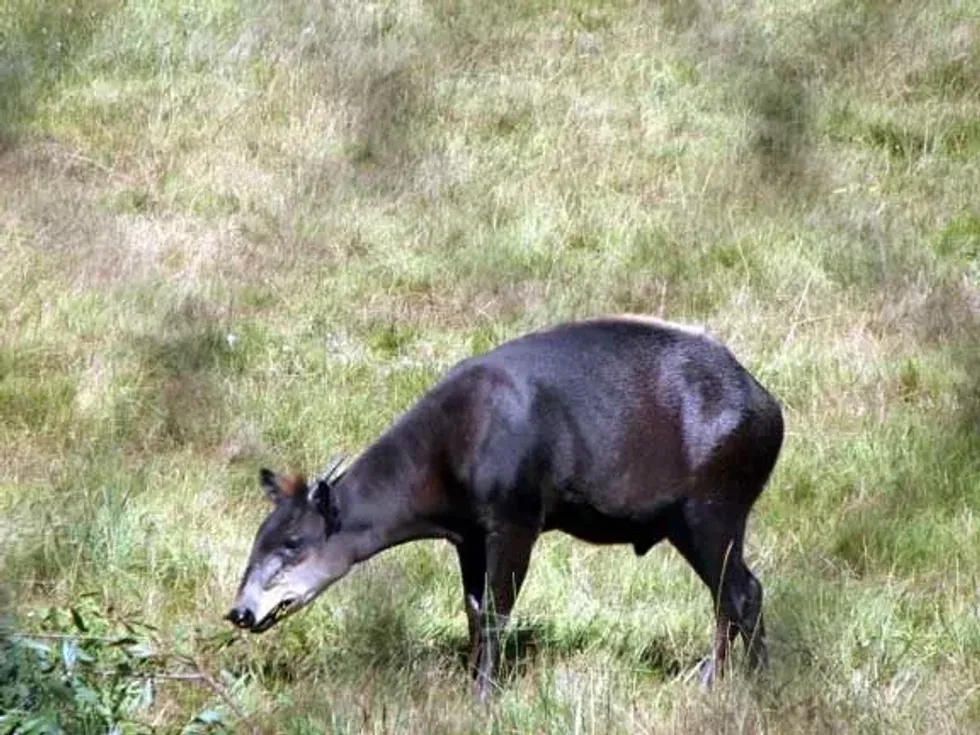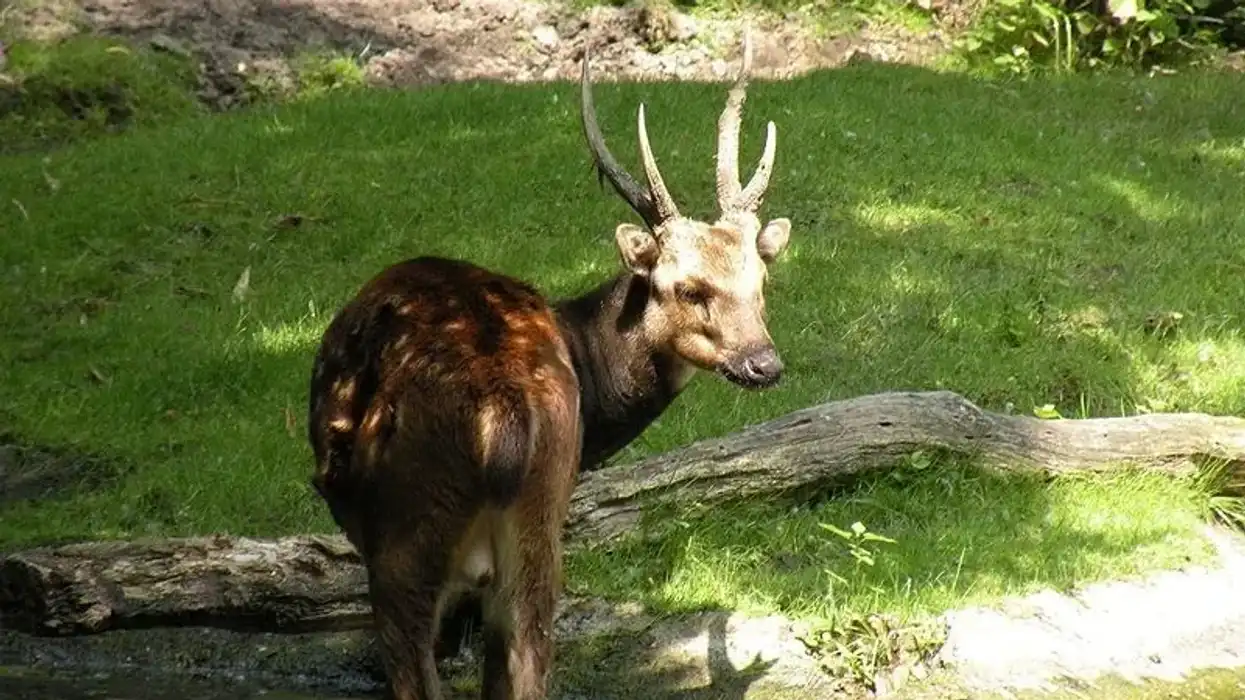The yellow-backed duiker (Cephalophus) with dark gray hair and rump may look kind of weird at a first. But the Cephalophus silvicultor has beautiful doe eyes like a deer, short horns, and fluffy ears with an orange crest of hair in between.
The shy duiker yellow-backed lives comfortably in its forest territory wildlife habitat. These forest duikers are peace-loving animals, and even the slightest trigger can send these backed duiker yellow antelopes diving for cover in a nearby bush in their safe territory.
Unfortunately, the species is categorized by the IUCN Red List as Near Threatened as this family of duikers is killed in large numbers by human hunting. However, it has been found that the duikers may live longer in captivity.
But, even in the controlled environment of zoos, even the slightest disturbance sends the duikers running into the glass enclosures leading to jaw abscesses.
The backed duiker (Cephalophus silvicultor) family is frugivorous and consumes mainly low-quality fruits and other parts of the plants, including shoots, roots, buds, and leaves. They are instrumental in seed dispersal and contribute to the development of agriculture in their habitat.
If you are interested in fun facts about similar animals, take a look at African civet facts and bat-eared fox facts.
Yellow-Backed Duiker Interesting Facts
What type of animal is a yellow-backed duiker?
The yellow-backed duiker (Cephalophus) is an antelope belonging to the forest wildlife of Africa. This backed duiker (Cephalophus silvicultor) is the largest antelope in its species in the world.
What class of animal does a yellow-backed duiker belong to?
The yellow-backed duiker (Cephalophus) animals belong to the class Mammalia, and they are the largest animals in their species in Africa.
How many yellow-backed duikers are there in the world?
According to the IUCN Red List, the conservation status of the backed duiker yellow has been classified as threatened. The population size of Duiker yellow-backed in the present status in the world has been found to be 1,60,000. They contribute to agriculture as they serve as seed dispersal agents; therefore, their conservation status is of major concern.
Where does a yellow-backed duiker live?
The largest duikers of the species Cephalophus silvicultor live in tropical and terrestrial habitats. The yellow-backed duiker can be easily found in the rain forests and riparian forests spread across western Uganda to Senegal. The backed duiker (Cephalophus silvicultor) is the most widely distributed species of duiker in the world.
What is a yellow-backed duiker's habitat?
This duiker species of Cephalophus silvicultor constitutes the wildlife of rain forests, semi-deciduous forests, montane forests, and riparian forests. The animals are well adapted to the forest duiker habitat in Africa.
Who do yellow-backed duikers live with?
The elusive Cephalophus silvicultor duikers are active during the day as well as the night. In fact, these yellow duikers are often seen alone or in couples of males and females in the wildlife of Africa. Very rarely, these adults may also travel in small herds with each other in their forest living territory.
How long does a yellow-backed duiker live?
The life span of backed duiker yellow of the species Cephalophus silvicultor duikers in the forest living habitat is 10-12 years, but these animals live up to 23 years in captivity.
How do they reproduce?
The yellow-backed duiker (Cephalophus) mating system is monogamous like other antelopes in the wildlife of Africa. In this family of antelopes, the female yellow-backed duiker (Cephalophus) becomes sexually active earlier than the duiker males.
The duiker species can reproduce one or two times annually, and they have a gestation period of up to seven months. The calf is kept hidden in its territory and weaned only three to five months after its birth.
What is their conservation status?
According to the IUCN, the status of the duiker yellow-backed is categorized as Near Threatened. This backed duiker (Cephalophus silvicultor) species makes an important contribution in maintaining agriculture and serves as prey for hunting.
Presently, the wildlife duikers are threatened by uncontrolled human encroachment in Africa. If proper steps are not taken to preserve the species it could soon become endangered.
Yellow-Backed Duiker Fun Facts
What do yellow-backed duikers look like?

This backed duiker yellow species has a convex body shape designed to help the duiker dive quickly for cover in the bushes. It is one of the largest antelopes found in the rain forests of Africa.
The adults have a unique yellow crest of hairs covering the back of their bodies. They secrete a unique scent that is used for communication with other duikers. The scents of duikers are used to mark their territory.
Both male and female yellow duiker antelopes are found in the picturesque forest islands with average weight, beautiful eyes, short horns, tail, and slender legs. They are harmless and feed on shoots, fruits, buds, and leaves of plants.
How cute are they?
The yellow-backed duiker is cute and adorable with beautiful eyes, a convex body shape, short horns, legs, and tail. This Cephalophus silvicultor duiker has earned the name duiker, which means diver in Africa, as even at the slightest excitation, it quickly dives for cover in a nearby bush.
The yellow-backed duiker (Cephalophus) has an orange crest of hair coloration between its horns and is a beautiful antelope.
How do they communicate?
Communication between yellow-backed duikers and other animals is through chemical, acoustic and visual modes. It has scent glands located behind its eyes that produce secretions with a unique scent that is used by the duikers for communication between each other. Acoustically they communicate with grunts, whistles, and shrill bleats.
How big is a yellow-backed duiker?
The yellow-backed duiker has a head and body length of 45.3-57.1 in (115 to 145 cm). The female's development is faster than the males. They are the largest among the other 16 African bovid species, including the saiga antelope.
How fast can a yellow-backed duiker run?
The exact speed is not available, but a yellow-backed duiker can run at an explosive speed as fast as Abbot's duiker.
How much does a yellow-backed duiker weigh?
The yellow-backed duiker weighs between 132.27 -176.37 lb (60-80 kg).
What are the male and female names of the species?
The yellow-backed duiker males are called bucks, and the females are called does.
What would you call a baby yellow-backed duiker?
A baby yellow-backed duiker is called a calf. It is born with red undersides, a dark brown coat, and spotted flanks.
What do they eat?
The yellow-backed duikers are very diet conscious, their main food source for their normal development is roots, shoots, buds, leaves, and a large amount of low-quality fruits from plants. Occasionally, the frugivores Duiker yellow-backed may also eat the meat of small birds.
Its main predators are eagles, leopards, jackals, pythons.
Are they dangerous?
They are not dangerous, in fact, the yellow-backed duikers are quite the opposite, they are docile and harmless animals. Even the slightest disturbance can send them diving back into the bush for shelter.
Would they make a good pet?
Ideally, the yellow-backed duikers are designed for wildlife living, but if you are very interested in adopting one, make sure it lives in a peaceful environment. These duikers are very edgy, and even the slightest trigger could send them running off blindly.
It has been reported in the Los Angeles zoo, duikers developed jaw abscesses after running headlong into the glass of their own enclosures.
Did you know...
Let us go through some more fun facts about duiker yellow-backed that have earned it the name duiker, meaning diver in Afrikaans, as even at the slightest trigger, the duiker quickly dives into a nearby bush for cover.
The duikers communicate mainly through their olfactory senses. They have special glands behind their eyes in the form of open pores. These special gland secretions have specific scents that can be identified by other duikers from the Cephalous silvicultor species. These secretions with a unique scent are used to mark their territory or to communicate with their mates.
Some hunters state that one could even hunt a duiker with a simple flashlight, as the duiker just freezes when light is flashed in its eyes. Currently, there is an increase in human encroachment of the Yellow-backed duiker, and the IUCN has categorized the species as near threatened.
How many different species of duikers exist?
There are 16 species of duikers.
How did the yellow-backed duiker get its name?
When this duiker is stressed, especially during hunting season by human encroachments, the yellow hair on its rump stands up, and it quickly dives into a nearby bush. So, it is popularly known as the yellow-backed duiker or backed duiker yellow.
Here at Kidadl, we have carefully created lots of interesting family-friendly animal facts for everyone to discover! Learn more about some other mammals from our kudu facts and klipspringer facts pages.
You can even occupy yourself at home by coloring in one of our free printable yellow-backed duiker coloring pages.









